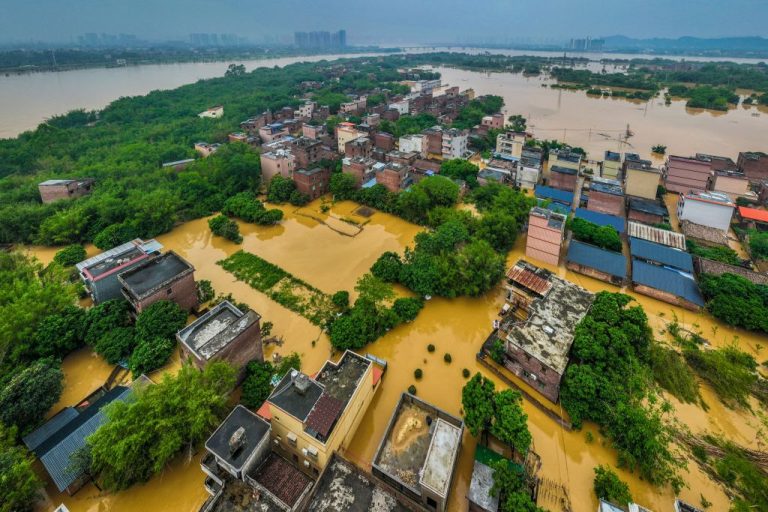In recent days, the southern Chinese province of Guangdong has become the focal point of a severe environmental and humanitarian crisis. Unprecedented levels of rainfall have resulted in catastrophic floods, leading to the evacuation of over 110,000 people, according to local authorities and state media.
Guangdong, China’s most populous province, is home to more than 127 million people. The region has experienced such intense rainfall that state media and eyewitnesses reported seeing “vast areas” completely submerged underwater.

According to state reports, the floods have already claimed four lives, with another 10 individuals reported missing. To make matters worse, the floods have caused massive socio-economic disruption, including massive power outages affecting approximately 1.16 million households, widespread destruction of property, and significant economic losses estimated at nearly 140.6 million yuan ($19.8 million).
Aquatic wastelands
The Pearl River Delta — a major manufacturing hub for the region — is particularly vulnerable due to its low-lying geography, which further exacerbates the effects of storms and sea-level rise. This vulnerability was highlighted over the past week as the relentless downpour caused several major rivers to overflow, transforming urban and rural landscapes into aquatic wastelands.

Local responses have been swift but strained, reports note. While authorities have moved droves of people to shelters, emergency services are struggling to rescue those trapped by debris and rising waters. Guangzhou, along with cities like Shaoguan and Heyuan, faced the brunt of the storm’s fury with significant disruptions in daily activities, including the shutdown of schools and delays and cancellations of flights at Baiyun International Airport.
Success
You are now signed up for our newsletter
Success
Check your email to complete sign up
RELATED: Record-breaking Rainfall Devastates Hong Kong As City Grapples With Worst Floods in Decades
“Please quickly take precautions and stay away from dangerous areas such as low-lying areas prone to flooding,” authorities in the coastal metropolis of Shenzhen, China’s third largest city, said as a red alert was issued. “Pay attention to heavy rains and resulting disasters such as water logging, flash floods, landslides, mudslides, and ground caving in,” the alert said.
In China and Hong Kong, a three-color tier system is used for weather alerts to signify the severity of meteorological events such as heavy rains, floods, and major disruptions. The system comprises three levels: amber, red, and black. Within this system, red and black represent a higher level of alert and indicate the most severe conditions. Black is used when the weather situation is expected to be extremely severe, with the possibility of major disruptions and potentially catastrophic conditions.
Worsening weather
The broader implications of these floods extend beyond immediate recovery, notes Yin Zhijie, chief hydrological forecaster at China’s Ministry of Water Resources. “Judging from the flood control situation in recent years, climate warming and temperature rise have intensified, and extreme heavy rainfall occurs every year, leading to torrential rains and floods,” said Yin.
The region’s economic vitality is also at risk, with potential long-term impacts on both local and international markets that depend on the manufacturing output from the Pearl River Delta. Furthermore, the psychological toll on the residents, as articulated by a Weibo user whose family had to relocate their belongings to higher floors as waters inundated their home, reflects a growing climate of fear and uncertainty.
“The heavy rains have flooded half of the first story of our home,” the user wrote on Weibo, a popular blogging and social media platform in China.. “I wonder if the second story would also be flooded overnight. I feel helpless.”
“It rained like a waterfall for one and a half hours on the highway when I was driving home last night,” another user shared on Weibo. “I couldn’t see the road at all.”

‘Factory floor of the world’
The crisis in Guangdong coincides with a damning report by the United Nations (UN), which identifies Asia as the region hardest hit by climate change in 2023. Dubbed “the factory floor of the world,” the region is frequently plagued with floods and other destructive events.
Meanwhile, China’s Meteorological Administration has also noted an “increase in extreme weather events,” with numerous national weather stations breaking rainfall records. Such data points to a trend that can no longer be ignored.

“Many countries in the region experienced their hottest year on record in 2023, along with a barrage of extreme conditions, from droughts and heatwaves to floods and storms,” said World Meteorological Organization (WMO) chief Celeste Saulo in a statement. She also noted that climate change has “exacerbated the frequency and severity of such events,” describing the report’s findings as “sobering.”
Now, “moderate to heavy” rain is expected in other parts of the country, including Beijing, Tianjin and Heibei, until at least April 24, the authorities warned.














